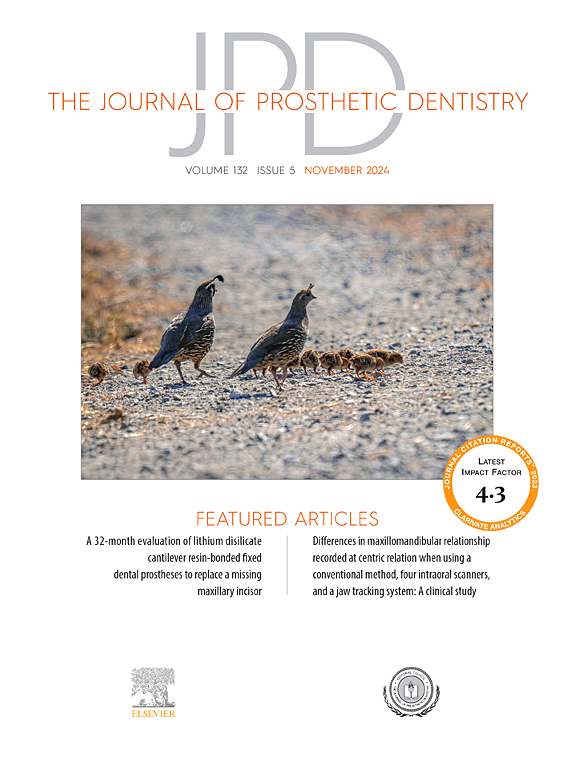Trueness of maxillary complete dentures duplicated by using conventional and 3D printing techniques: A comparative in vitro study
IF 4.3
2区 医学
Q1 DENTISTRY, ORAL SURGERY & MEDICINE
引用次数: 0
Abstract
Statement of problem
Duplicating complete dentures and achieving accurately fitting prostheses poses a challenge. Conventional methods are often time-consuming and susceptible to human error. Advancements in digital technology for denture fabrication offer a promising alternative to conventional duplication techniques, but studies comparing the methods are lacking.
Purpose
The purpose of this in vitro study was to compare the trueness of duplicated complete dentures using 3-dimensional (3D) printing technology with that of dentures duplicated using the conventional method.
Material and methods
A typodont was used to construct a maxillary complete denture using the conventional method. The denture was scanned using a desktop scanner, and the standard tessellation language (STL) file was considered the reference file. Each denture was duplicated using 3 techniques (10 in each group). In the first group, the denture was duplicated using the conventional technique; in the second group, the denture was printed as a single unit (monolithic) from a tooth-colored resin, and the denture flange was then veneered with pink resin; in the third group, the denture base was printed separately from the pink resin, and the teeth were printed as a single unit using tooth-colored resin. The denture base and the teeth were co-related using a positioning device. The duplicate dentures in the 3 groups were scanned, and the STL files were imported into a surface-matching software program to evaluate their trueness. Statistical analysis was done using 1-way ANOVA followed by the Tukey post hoc test (α=.05).
Results
A significant difference (P<.001) was found in the trueness of the 3 duplication techniques, with the highest overall deviation recorded in the conventional denture group (0.73 ±0.06 mm) and the least deviation recorded in the monolithic denture group (0.21 ±0.04 mm). Deviations in the canine, first molar, and maxillary tuberosities were the lowest in the monolithic denture group (0.13 ±0.01 mm), (0.11 ±0.03 mm), (0.27 ±0.05 mm), respectively.
Conclusions
Using 3D printing technology for complete denture duplication has a promising outcome with the highest trueness reported with the monolithic denture. Comparative clinical studies are needed.
传统和3D打印技术对上颌全口义齿复制正确率的体外比较研究。
问题陈述:复制全口义齿和实现准确装配义齿是一个挑战。传统的方法往往耗时且容易出现人为错误。数字技术的进步为义齿制造提供了一种有希望的替代传统复制技术,但缺乏比较方法的研究。目的:本体外研究的目的是比较三维(3D)打印技术复制的全口义齿与常规方法复制的全口义齿的正确率。材料和方法:采用传统的方法,采用排印支架构建上颌全口义齿。采用桌面扫描仪对义齿进行扫描,以标准镶嵌语言(STL)文件作为参考文件。每个义齿采用3种方法复制(每组10个)。第一组采用常规方法复制义齿;在第二组中,用牙齿颜色的树脂将义齿打印为单个单元(整体),然后用粉红色树脂贴面义齿法兰;在第三组中,义齿基托与粉色树脂分开打印,牙齿作为一个整体使用牙色树脂打印。使用定位装置将义齿基托与牙齿相互关联。对3组重复义齿进行扫描,将STL文件导入表面匹配软件程序,评估其真伪。统计学分析采用单因素方差分析和Tukey事后检验(α= 0.05)。结论:采用3D打印技术进行全口义齿复制具有较好的效果,全口义齿的正确率最高。需要进行比较临床研究。
本文章由计算机程序翻译,如有差异,请以英文原文为准。
求助全文
约1分钟内获得全文
求助全文
来源期刊

Journal of Prosthetic Dentistry
医学-牙科与口腔外科
CiteScore
7.00
自引率
13.00%
发文量
599
审稿时长
69 days
期刊介绍:
The Journal of Prosthetic Dentistry is the leading professional journal devoted exclusively to prosthetic and restorative dentistry. The Journal is the official publication for 24 leading U.S. international prosthodontic organizations. The monthly publication features timely, original peer-reviewed articles on the newest techniques, dental materials, and research findings. The Journal serves prosthodontists and dentists in advanced practice, and features color photos that illustrate many step-by-step procedures. The Journal of Prosthetic Dentistry is included in Index Medicus and CINAHL.
 求助内容:
求助内容: 应助结果提醒方式:
应助结果提醒方式:


